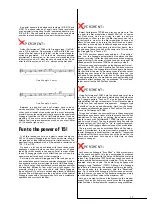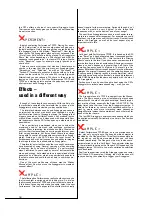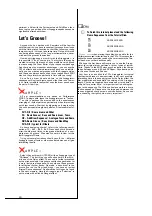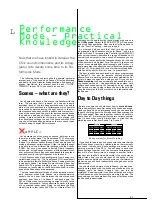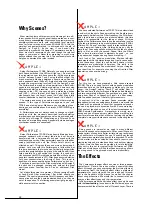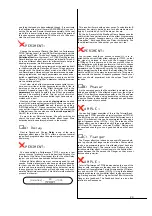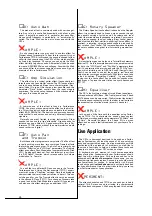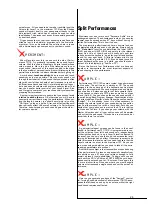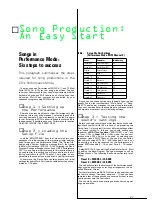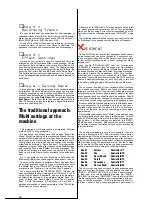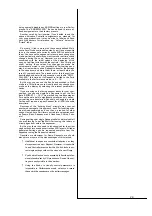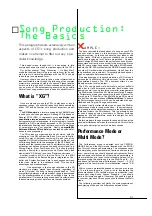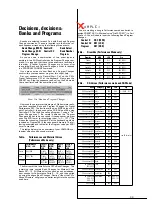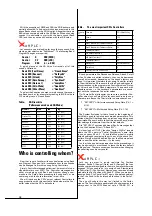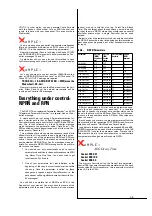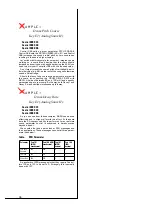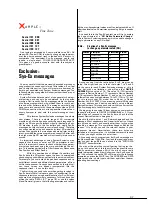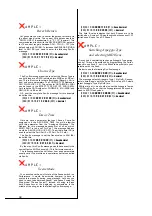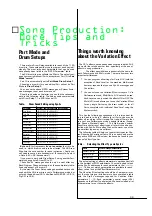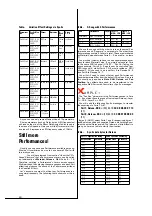
25
noise for you. All you need to do to make it audible is set the
Volume for Layer1 to the maximum 127. Now the Rhodes
sound will assert itself in your arrangement thanks to this
little insider‘s trick, which can of course be used for other
tonal shades. The presence of a sound is especially governed
by its attack phase.
Organ sounds too run the risk of sounding too dull and can
often be lost in the battle for prominence in the live instru-
ment war. This can be avoided. The solution here is to use
add a harmonically rich component to your basic sound.
PERIMENT:
We will explain how this is done with the aid of Perfor-
mance TP116. Try gradually increasing the second Layer‘s
volume. With this you are blending in a digital sound, whose
sole purpose in life is to add a little transparency to your
organ sound. How much of this sound you add to the organ
is really a matter of personal taste. It is worth listening to this
partial tone in isolation to better understand what‘s going on.
A word about touch sensitivity: keep your sound‘s touch
sensitivity as low as possible. This way many sounds cut
through the mix better. A pad sound that you probably often
play with your left hand shouldn‘t really respond to touch at
all. Experience has shown that it is far more practical to con-
trol a pad sound‘s volume with a volume pedal or fader. That
way you have far better control of your sound‘s level. Also
don‘t forget to ‘compress’ your touch sensitivity values when
preparing Performances.
Another important step is to ensure that you sounds’ levels
relative to each other are OK, otherwise you will have to
constantly correct them during the performance. When set-
ting the levels, however, you should not simply rely on the
“Perf Level” value as a guide. Filter and effect settings will
also indirectly affect the overall volume of a Performance.
Therefore, keep listening to each sound against the other –
let your ears decide.
Split Performances
Musicians that don‘t work with “Keyboard Splits” are an
endangered species. The advantages are clear: you can play
several sounds spread across 61 keys without having to
switch Performances. This is how it‘s done: -
The programming effort required here is minimal and can
be mastered effortlessly, even by beginners. Simply call-up
the “Note Limit” function and determine the lower (LIMIT
LOW) and upper (LIMIT HIGH) end points for the relevant
Layer. As a rule of thumb you will usually only split two
sounds across the keyboard, a pad for your left and another
sound for your right hand. A little tip: always stick to the
same split point, e.g. middle C (C3). If you do need to use dif-
ferent keyboard splits once in a while, you should make a
note of it in the display (e.g. “Pad/Pno-F3”).
Set out bellow are four Performances that we have put
together to demonstrate the most important aspects of
sound shaping for live performance.
A M P L E :
Performances TP117-120 contain typical live performance
split sounds. The split point is always at C3. The sound
assigned to the upper part of the keyboard can be played
from this point onwards. We have programmed a combina-
tion of pad and E-piano sounds for our first example (Split-
1), the second consists of a CP70 piano as well as an organ
sound (Split-2). You can change the sounds used quickly if
you wish using Bank/Program changes. Pay attention also to
the effect settings. Now let‘s look at the purpose of controller
“Assign2”. As we already know, it is often necessary to
change the volume levels of your sound during live perfor-
mance, either manually or with a foot pedal. Let‘s say you
decide that your pad sound is way too loud. This is the trap
spilt sounds fall into: if you change your volume with the
Master Volume control, all your split sounds will be quieter
and not just the pad sound. This can be a real nuisance, but
never fear, there is a solution:
A M P L E :
A particularly elegant solution can be found in the use of
Knob6. In Performances TP117/119 it is programmed to con-
trol the volume of your left hand sound only, independently
of the right hand sound, i.e. only Layer1‘s level is affected. To
be exact, you can only use the knob to decrease the level;
turning it clockwise has no effect. If however you want to be
able to increase the level as well you need to ensure that the
Layer‘s volume is not set to the maximum 127. As you can
see, when using modulation you need to take all the corre-
sponding parameters into account.
Another dicey subject is the transposition of sounds during
a live performance. A piano sound especially benefits from
this ability as even 61 keys aren‘t always enough to fully
exploit a piano‘s tonal possibilities. To begin with you can
work with the CS1x‘s Shift and PART/LAYER keys to trans-
pose an entire octave by up to +/-3 octaves. Once again, this
is more tricky with split sounds, where you would usually
only want to transpose a single sound and not the entire Per-
formance.
A M P L E :
Here too you can make good use of the “Assign2” control-
ler. Turning Knob6 clockwise in Performances 118/120 trans-
poses the left hand sound up by an octave, whilst the right
hand sound remains unaffected.







